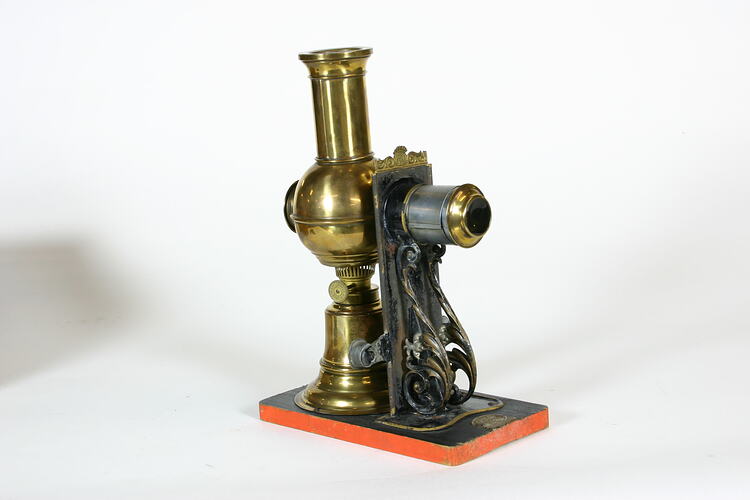Summary
Children's toy magic lantern projector, designed for domestic use with circular glass slides. Includes box and two circular slides. The 'Brass Climax' was a special variant of the 'Climax' model and was produced specifically for the British and United States markets. The body is of polished brass and uses a single wick kerosene burner as an illuminant. The ornate slide holder is of die pressed metal and incorporates the company logo (wings on either side of a four-spoked wheel and the initials E.P.).
When originally bought, the lantern would have come in the marked box complete with an assortment of slides, one of which, a circular slide, remains. While the standard slide holder takes rotating disc slides, the box would normally contain accessories which allowed for the use of strip slides as well.
Ernst Plank, the manufacturer, was founded in 1866 and produced tin toy trains and boats, as well as magic lanterns. At one time it was the second largest manufacturer of magic lanterns in Nuremberg, Germany. Nuremberg was a major centre for metal toy production and export in the latter part of the 19th century and up to World War I.
While the invention of the magic lantern is generally seen to be in the 17th century, its greatest popularity as an optical projector spans the late 18th Century to the early decades of the 20th Century. It was used both as a means of entertainment and education.
This lantern projector is part of the Francis Collection of pre-cinematic apparatus and ephemera, acquired by the Australian and Victorian Governments in 1975. David Francis was the curator of the National Film and Sound Archive of the British Film Institute as well as being a co-founder of the Museum of the Moving Image in London, which was operational between 1988 and 1999.
Physical Description
Brass spherical body, incorporating a single wick illuminant controlled by brass nut. The projection barrel is composed of tin, while the lens is encased in a brass housing. A decorative slide holder of blackened tin takes circular slides, typically made up of six individual pictures. Gold coloured trim is a feature, with the slide holder exhibiting a pressed metal decoration incorporating the manufacturer's logo of a winged wheel above the initials E.P.
More Information
-
Collection Names
-
Collecting Areas
-
Acquisition Information
Loan & Subsequent Donation from Australian Film Institute (AFI), Mr David Francis, by Nov 1990
-
Manufacturer
Lantern Slide & Toy Producers, Ernst Plank, Nuremberg, Bavaria, Germany, 1890s
-
Collector
Mr David Francis, London, Middlesex, England, Great Britain, 1990
-
Inscriptions
Medallion fixed to base plate. Trade mark of winged wheel and initials 'E.P./ MADE IN GERMANY.' Trade mark of winged wheel and initials 'E.P.' on upper edge of slide holder. On illuminant control 'WIENER FLADHBRENNER'
-
Classification
-
Category
-
Discipline
-
Type of item
-
Overall Dimensions
170 mm (Length), 98 mm (Width), 237 mm (Height)
-
Maximum dimensions
69 mm (Length), 97 mm (Width), 238 mm (Height)
Measurement From Conservation.

